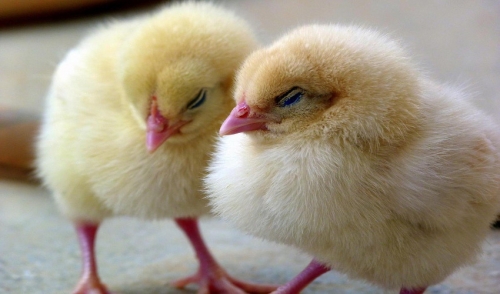{article.name}
Common Chick Diseases to Look Out For

- Share this:
- Share on Facebook
- Pin on Pinterest
- Tweet on Twitter
A healthy chick will grow strong and be a productive member of your flock, but a sick chick can quickly infect other chicks or introduce diseases to the rest of your poultry. Left untreated, many chick diseases have alarmingly high mortality rates, but fortunately it can be easy to spot diseases so you can avoid purchasing unhealthy birds or take steps to help them recover and protect the rest of your flock.
Most Common Chick Diseases
There are a wide variety of illnesses that can infect young chicks, and some types of poultry are more susceptible to different diseases than others. The most common, widespread diseases include…
- Infectious Bronchitis
This cold-like illness shows symptoms such as gasping and other respiratory trouble, sneezing, watery eye or nasal discharge and loss of appetite. Raising the temperature in the brooder slightly (3-5 degrees) can help chicks better resist the infection, and offering a warm, moist mash will help them eat properly as they recover.
- Rot Gut
This bacterial infection causes rotten-smelling diarrhea and signs of listlessness or depression in infected chicks. The infection spreads largely through overcrowding, and keeping chicks in a properly-sized brooder will help reduce the risk of infection. Regular cleaning is essential to minimize the disease, and antibiotics administered in the water can help cure infected chicks.
- Aspergillosis
Also called brooder pneumonia, this disease is caused by a fungus. Infected chicks will lose their appetites but have increased thirst, and they may also begin gasping or show convulsions. Keeping a clean brooder, including all bedding, waterers and dishes, as well as improving ventilation in the area will help minimize this disease.
- Fowl Pox
Though it is not related to the chicken pox humans can get, fowl pox does create wart-like growths or sores on infected birds. Slow growth and canker in the mouth are other symptoms of fowl pox. This virus is spread by infected mosquitoes, and spraying for mosquitoes is the best way to keep the disease from infecting a flock. Vaccinations can also be effective.
- Marek's Disease
This is a type of cancer that infects young chickens and chicks, and may show as lameness or paralysis as well as blindness or labored breathing. Improving ventilation in the coop and brooder can help prevent the disease, as can good cleanliness and the appropriate vaccination.
- Avian Encephalomyelitis
This disease shows symptoms such as dull eyes, head and neck tremors, appetite loss and eventual paralysis. It is spread through fecal contamination of food and water, but unfortunately there is no cure and infected chicks will need to be killed and disposed of safely. A vaccine is available and can be effective to prevent the disease if it is administered properly.
Keeping Chicks Healthy
Because many of the most common diseases to infect chicks have similar symptoms and very high mortality rates, it is important to take all possible steps to keep chicks healthy. Always inspect new chicks thoroughly for any signs of illness, and keep chicks isolated and quarantined from the rest of the flock to be sure they don't inadvertently spread any contagion. Keeping brooders, coops, roosts and runs appropriately ventilated and clean is essential, and be sure all birds have adequate space to prevent overcrowding. Feed your poultry a healthy diet to boost their immunity, and they will be better able to resist any infections or contaminants they come into contact with.
Special Offers
We are constantly adding new specials to our site. Be sure to check back often!


Comments